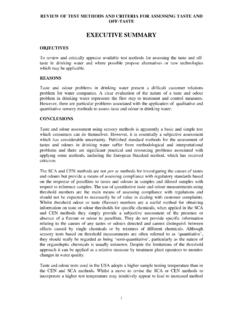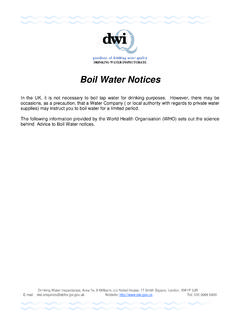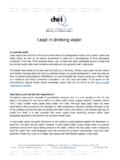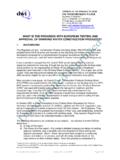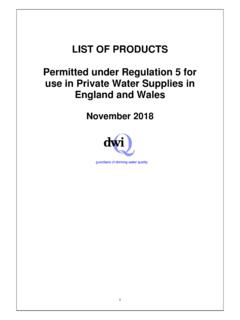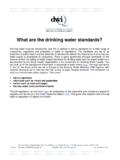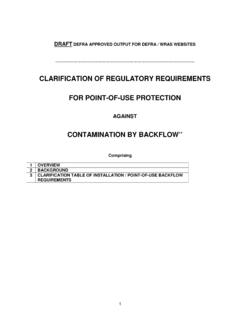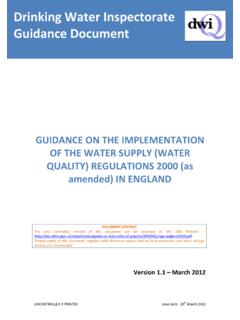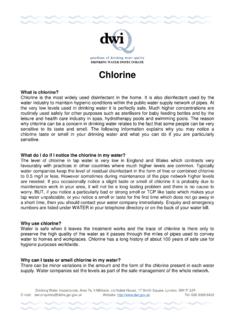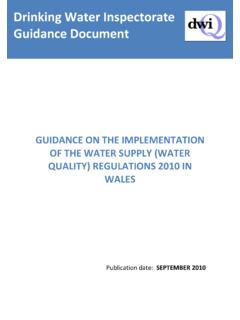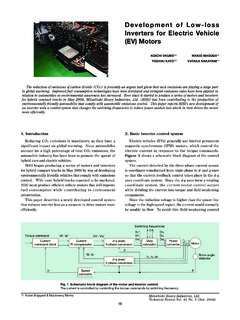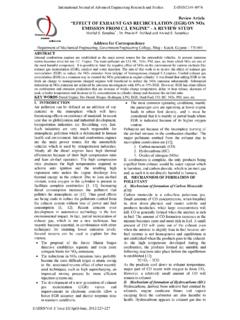Transcription of UK WATER INDUSTRY RESEARCH LIMITED …
1 UK WATER INDUSTRY RESEARCH LIMITED ALTERNATIVES TO phosphate FOR plumbosolvency control executive summary objectives One of the key objectives for this project was to determine the current situation regarding WATER company approaches to meeting the new drinking WATER standard for lead of 10 g/l, which is to be applied from December 2013. This was achieved via a questionnaire and was supplemented by reviews of approaches applied in other countries across the world. The questionnaire sought to determine a wide variety of quantitative and qualitative data including the amount of residual lead in the tap WATER distribution system, the degree and cost of phosphate dosing, WATER quality data, consideration of alternatives and stakeholder engagement.
2 The data from the questionnaire as used as the basis of a spreadsheet-based economic tool that will enable users to estimate the costs and benefits of baseline phosphate dosing costs and alternatives (lead pipe replacement and/or rehabilitation) whilst including wider economic costs and benefits associated with achieving the new drinking WATER standard for lead of 10 g/l. Wider impacts include chemical usage at wastewater treatment works, carbon emissions, health implications and wider benefits of phosphate dosing such as reducing copper levels in tap WATER . Conclusions Based on the questionnaire, literature review and spreadsheet model outputs, the following conclusions may be drawn: Alternatives to phosphate dosing to meet the new lead standard far out weight the current cost of phosphate dosing and without remediation of customer supply lead pipes will be unlikely to achieve compliance.
3 Lead rehabilitation ( lining) has been previously tested, but has yet to be widely applied, although a new method is currently undergoing trials and would be cheaper than replacement as fewer excavations are required and many more properties can therefore be completed within any given day. Replacement of communication pipes alone, in many cases does not ensure compliance with the new 10 g/l lead standard and so phosphate dosing is required at least until customer supply pipes are replaced and in some cases replacement of internal plumbing and fittings containing lead. Sixteen WATER companies responded in some way to the questionnaire, representing a population served of 40 million customers.
4 Of the companies who responded 91% of the population served are now receiving drinking WATER dosed with phosphorus. phosphate dosing reduces the measured lead concentrations at the tap substantially. Mean phosphate dosing concentrations across all zones for any given WATER company ranged from mg-P/l to mg-P/l, leading to a current rate of compliance with the 10 g/l standard of approximately 99%, but which varies by company and by zone. phosphate dosing appears to provide a number of other benefits including reduced copper leaching from plumbing and probably reduced iron. There seems to be no adverse impact on microbial compliance.
5 A spreadsheet economic model has been developed at a zonal scale for WATER companies to take account of all of the key variables required to cost current phosphate dosing strategies as well as alternatives such as lead replacement or rehabilitation. Ancillary impacts on wastewater treatment, carbon emissions and health are also monetised. The model has been developed to provide WATER companies with a tool to assist in PR14 planning. Using data provided by one company as a worked example, the cost of replacing all communication pipes only would amount to over 390 million at net present value taking account of replacement costs and chemical savings.
6 Benefits in chemical savings only amounting to about 10% of the lead replacement costs. Only replacing communication pipes also suggests a significant dis-benefit in health impacts as lead levels would increase above current levels should phosphate dosing cease. Replacing communication and supply pipes was estimated to add up to over 890 million. Chemical costs ( phosphate for tap WATER dosing or iron use at WwTW) would have to increase by at least a factor of 20 before lead replacement would be economically viable, Furthermore, the model demonstrates the importance of remediation of customer supply pipes as well as company communication pipes in order to meet compliance with the new standard and maintain health benefits.
7 Recommendations The outcome from the project is identification of a number of recommendations associated with improving input data as well as development of the tool; these are discussed below. Improving input data 1) The model is driven by the estimated number of lead pipes (communication and supply) that require remediation, which is very uncertain. Companies should seek to improve estimates to increase the quality of the economic assessment. 2) The costs of pipe replacement require consideration by individual WATER companies as they appear to vary considerably across zones and companies. Also as information for costs of pipe rehabilitation become apparent the model should be updated to reflect more accurate costs and lifespan of any lining material as it has a significant influence on overall costs and could influence future decision making processes.
8 3) There is significant uncertainty associated with some of the ancillary factors: a. Copper The model input values should be reviewed once there is clarity regarding future permitting policy under the WFD. Each WATER and sewerage company will need to assess the risk of attracting new copper permits at WwTW within their region and amend the spreadsheet model accordingly. b. Iron Stopping phosphorus dosing would lead to a reduction of phosphorus loads received by WwTW. The reduction in load may vary from around 10 to 20%. The model assumes that this phosphorus reduction can be mirrored by a reduction in the load of iron used per annum for WwTW with a P permit.
9 WATER companies should confirm that any modest reduction in phosphorus loads to WwTW can actually lead to iron saving at the WwTW. c. Health The assumptions regarding the health benefits of reducing lead levels in drinking WATER are necessarily uncertain owing to a lack of data, particularly regarding the health implications of children exposed to low levels of lead in drinking WATER (at the low g/l range) and also the linkage between improved IQ and earning potential. Further RESEARCH is required to improve upon these assumptions and so periodic reviews of literature should be carried out to determine if better data exists.
10 Improving the model 1) Environmental benefits - it is recommended that once the source apportionment project has been completed (UKWIR, WW02) the significance of phosphate dosing on river WATER quality is reviewed and should the data suggest that the benefits are worth costing then the inclusion of environmental benefits in the economic model should be reconsidered. 2) User group once WATER companies have had time to populate the tool with their own data and become familiar with it, it is recommended that a user group is convened to discuss any improvements that could be carried out in a revised version of the model, particularly regarding easy of use, additional functionality, bugs etc.
